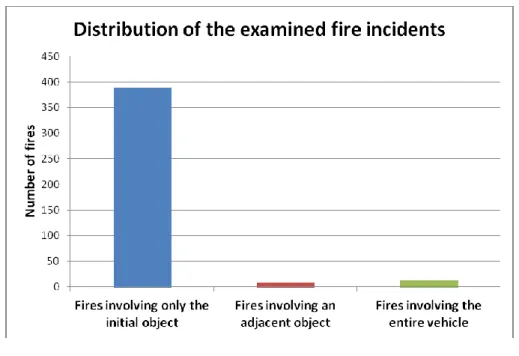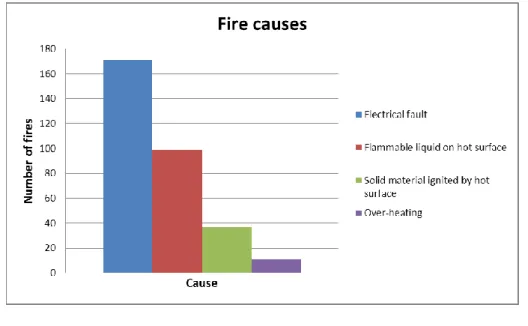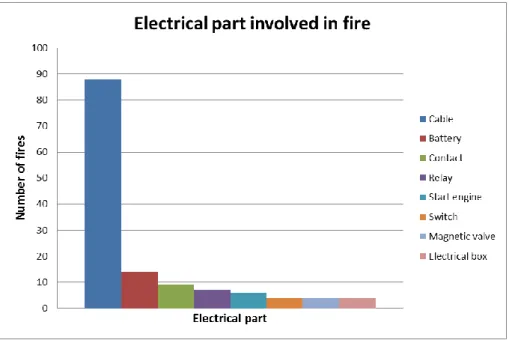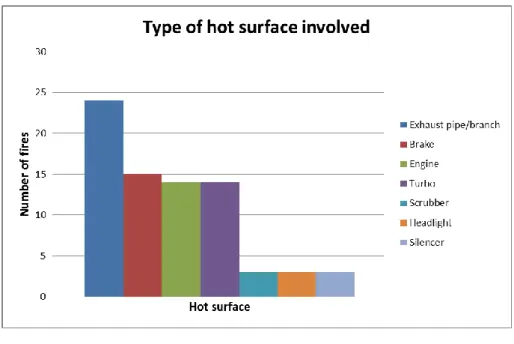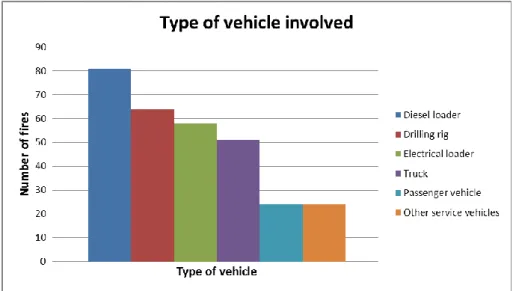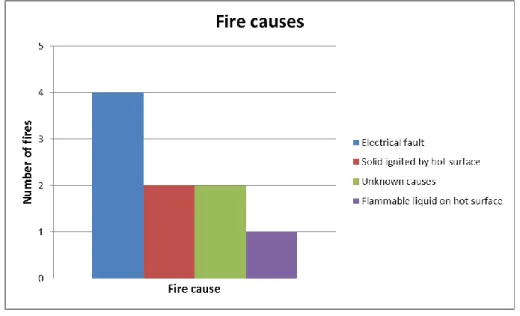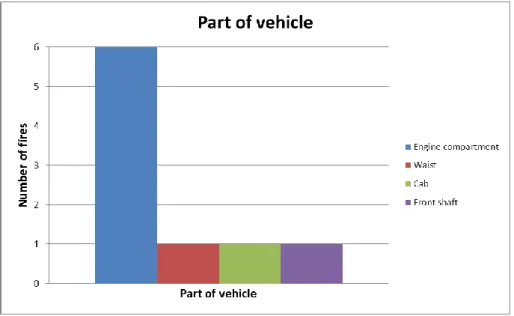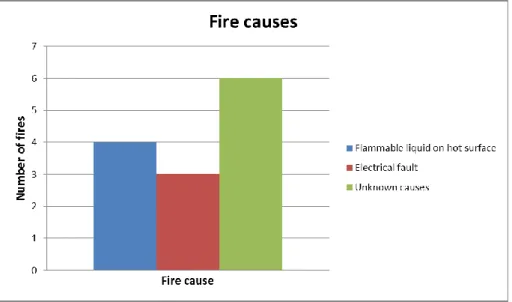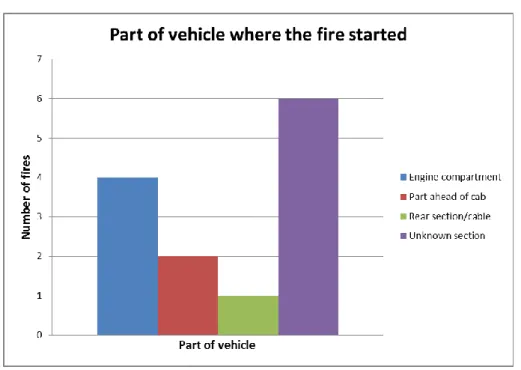FIRE CAUSES AND FIRE
BEHAVIOUR
Vehicle fires in underground mines in Sweden
1988–2010
INVESTIGATION ON
FIRE CAUSES AND FIRE
BEHAVIOUR
Vehicle fires in underground mines in Sweden
1988–2010
Studies in Sustainable Technology
in-bjuder lärare och forskare att publicera resultat från forsknings- och utvecklings-arbeten. Det kan exempelvis handla om teoretiska frågeställningar, genomförda experiment, rapportering från samverkans- eller samproduktionsprojekt eller från externa uppdrag.
Skriftserien omfattar forskningsrap-porter, arbetsrapporter och student-rapporter. Forskningsrapporter är på en högre vetenskaplig nivå och ska därför granskas av behörig forskningsledare eller professor. Arbetsrapporter kan t.ex. utgöras av beskrivningar av delförsök och ut-redningar som kan ligga till grund för kommande paper eller forskningsrapporter. Studentrapporter kan t.ex. utgöras av examensarbeten med extern uppdragsgivare. Arbets- och studentrapporter ska seminarie-behandlas före publicering.
Manuskript lämnas till redaktören, som ombesörjer slutlig granskning och redigering inför publicering. Varje författare är dock själv ytterst ansvarig för skriftens veten-skapliga kvalitet.
Studies in Sustainable Technology invites
teachers and researchers to publish results from research and development work. It can e.g. be about theoretical topics, carried out experiments, reports from cooperation or coproduction projects or from external assignments.
The publication series includes research, work and student reports. Research reports are at a higher scientific level and should therefore be examined by a research director or professor within the research field of the study. Work reports may e.g. consist of descriptions of pilot studies or studies as a basis for future papers or research reports. Student reports may e.g. consist of master theses for external principals. Work and student reports should undergo a seminar prior to publication.
Report scripts are to be submitted to the editor for a final review and editing before publication. The author, though, is solely responsible for the scientific quality of the report.
S
TUDIES IN
S
USTAINABLE
T
ECHNOLOGY
Work Report: 2013:3
Title: Investigation on fire causes and fire behaviour
Subtitle: Vehicle fires in underground mines in Sweden 1988–2010 Author: Rickard Hansen
Keywords: Vehicle fires, underground mines, fire causes, statistics Language: English
ISBN: 978-91-7485-119-9
Copy Editor: Mikael Gustafsson, mikael.gustafsson@mdh.se Publisher: Mälardalen University
Print: Arkitektkopia AB Mälardalens högskola
Akademin för ekonomi, samhälle och teknik Box 883
721 23 Västerås www.mdh.se
Mälardalen University
School of Business, Society and Engineering P.O. Box 883
SE-721 23 Västerås Sweden
www.mdh.se
Contents
LIST OF FIGURES ... 4 PREFACE... 5 ABSTRACT ... 7 1 INTRODUCTION ... 9 2 BACKGROUND ... 11 3 DATA MATERIAL ... 124 FIRES INVOLVING ONLY THE INITIAL OBJECT ... 14
5 FIRES INVOLVING AN ADJACENT OBJECT ... 19
6 FIRES INVOLVING THE ENTIRE VEHICLE ... 22
7 ANALYSIS AND DISCUSSION ... 25
8 CONCLUSIONS ... 27
Investigation on fire causes and fire behaviour
4 Rickard Hansen
List of figures
Figure 1. The distribution of the involved fire incidents ... 13
Figure 2. Most common fire causes – fires involving only the start object ... 14
Figure 3. Electrical parts most commonly involved in vehicle fires encompassing only the start object ... 15
Figure 4. Most common hot surfaces involved in ignition of vehicle fires ... 16
Figure 5. Types of vehicles involved in fires encompassing only the start object ... 17
Figure 6. The most common vehicle sections where fire occur ... 17
Figure 7. The most common fire causes; fires spreading to an adjacent object ... 19
Figure 8. The types of vehicles involved; fires spreading to an adjacent object ... 20
Figure 9. The section of vehicle where the fire occurred; fires spreading to an adjacent object ... 21
Figure 10.The most common fire causes; fires involving the entire vehicle ... 22
Figure 11.The vehicle sections most commonly involved in vehicle fires encompassing the entire vehicle ... 23
Preface
This report is part of the research project “Fire spread and heat release rate of underground mining and tunnelling vehicles – BARBARA”, conducted by a research group at Mälardalen University.
The project is aimed at improving fire safety in mines and tunnels during construction in order to obtain a safer working environment for the people working for the mining companies as well as the tunnelling companies in Sweden or for visitors in mines open to the public.
The following organisations are participating in the project: Mälardalen University, LKAB, Atlas Copco Rock Drills AB, Björka Mineral AB, Skanska Sverige AB and Svensk Kärn-bränslehantering AB.
The project has been funded by KK Stiftelsen (the Swedish Knowledge Foundation). Västerås in September 2013.
Abstract
This report is part of the research project “Fire spread and heat release rate of underground mining and tunnelling vehicles – BARBARA”, conducted by a research group at Mälardalen University.
The project’s aim is to improve fire safety in mines and tunnels during construction in order to obtain a safer working environment for the people working for the mining companies as well as the tunnelling companies in Sweden or for visitors in mines open to the public.
This report deals with the second step in the project: the investigation regarding fire causes and fire behaviour of vehicle fires in underground mines based upon material from GRAMKO (the work environment committee of the mine and mineral industry in Sweden). The main purposes of the investigation are:
To investigate and present fire causes, types of vehicles involved in fires, fire spread and fire behaviour of vehicle fires in underground mines.
To give recommendations on the continued work with the full-scale fire tests regarding the initial fire and its position.
The conclusions were that:
With respect to vehicle fires involving only the start object, a typical fire occurs in a loader or a drilling rig and is due to electrical fault – for example short-circuit of cables – in the engine compartment, resulting in a slow and limited fire spread.
Regarding vehicle fires limited to the start object and an adjacent object is that it usually occurs in a loader and is due to electrical causes, resulting in a slow and limited fire spread. Typically, electrical cables would play an important role when it comes to the fire spread to adjacent objects.
Vehicle fires involving the entire vehicle usually occur in a service vehicle or a loader and are typically caused by diesel being sprayed – for example due to a pipe/hose coming loose – on the engine, resulting in a rapid fire spread.
In future full-scale fire experiments involving a diesel loader and a drilling rig, the vehicles will have to be ignited using a diesel fire – for example a pool fire under-neath or inside the engine compartment – that is shielded and positioned close to
Investigation on fire causes and fire behaviour
8 Rickard Hansen
larger amounts of combustibles – such as tires or hydraulic hoses – and
continuously distributed fuels – such as electrical cables – in order to achieve a rapid fire growth and fire spread that eventually engulf the entire vehicle.
1
Introduction
Research regarding fire safety in mines has so far mainly been directed towards coal mines. Thus the need for additional knowledge, recommendations, models, engineering tools etc. for hard rock underground mines are in great need.
This aim of the current research project “Fire spread and heat release rate of underground mining and tunnelling vehicles – BARBARA” is to improve fire safety in mines and tunnels during construction in order to obtain a safer working environment for the people working for the mining companies as well as the tunnelling companies in Sweden or for visitors in mines open to the public.
The research project continues where the research project GRUVAN ends and focuses on the issue of vehicles in underground structures. The project consists of different steps, where each step is based on results and knowledge from the earlier steps. The steps are: literature survey, investigation regarding fire causes and fire behaviour during vehicle fires in underground mines (research involving incident reports), small-scale fire experiments involving equipment details from vehicles found in underground structures and finally full-scale fire experiments in a mine involving mining and tunnelling vehicles.
This report deals with the second step in the project, i.e. an investigation regarding fire causes and fire behaviour during vehicle fires in underground mines.
The main purposes of the investigation are:
To investigate and present fire causes, types of vehicles involved in fires, fire spread and fire behaviour of vehicle fires in underground mines.
To give recommendations on the continued work with the full-scale fire tests regarding the initial fire and its position.
The data source for this investigation has been incident reports from vehicle fires in underground Swedish mines provided by GRAMKO [1] (the work environment committee of the mine and mineral industry in Sweden).
The output of the project will mainly consist of:
Measured values from the full-scale tests. Few full-scale tests have been performed and the measures values are important in order to be able to use the model for creation of design fires for underground structures.
The developed model in the GRUVAN project can be validated and the results will also be of use to future projects.
Investigation on fire causes and fire behaviour
10 Rickard Hansen
The findings in the field of ignition and fire spread will be of value for manu-facturers designing new vehicles and machines and for fire prevention in new as well as existing vehicles.
The results regarding fire spread, heat release rate and smoke production will be useful in the work with fire safety during construction of tunnels and in the mining industry. These results will also be of great importance for the fire- and rescue services in their contingency planning.
2
Background
An earlier performed analysis of mobile equipment fires in US mines [2] examined the mobile equipment fires for all US surface and underground coal and metal/non-metal mining categories. In the analysis ignition sources, methods of fire detection and suppression, and other variables were examined.
A total of 24 equipment fires occurred in underground metal/non-metal and stone mines, involving mostly scoops, locomotives, haulage/utility trucks, loaders and power scalers.
Most fires were caused by pressurized hydraulic fluid sprayed onto equipment hot surfaces (50%) followed by electrical short/arcing and flammable liquid/motor/fuel oil on hot surfaces.
Most of the hydraulic fluid fires grew out of control because of the continuous flow of fluids due to engine shutoff failure, lack of an emergency line drainage system, or lack of effective and rapid local fire-fighting response capabilities.
This report presents a similar investigation for vehicle fires in Swedish underground mines, mainly focused on the fire cause and fire behaviour. Open pit mines are not included in the investigation. The investigation comprises the time period 1988–2010.
Investigation on fire causes and fire behaviour
12 Rickard Hansen
3
Data material
The data source for this investigation has been incident reports from vehicle fires in underground Swedish mines provided by GRAMKO [1] – the work environment committee of the mine and mineral industry in Sweden. The purpose of the committee is to act for the reduction of the number of fires among the mining companies. All fire incidents and incidents that could have led to a fire at a mining company are reported through incident reports to the committee and presented in a yearly report. The purpose of the report is to allow the different mining companies to compare their activities between each other, thus exchanging experiences, results etc. The incident report database managed by GRAMKO contains reports of fires or incidents that could have led to a fire, where the fires and incidents are divided into three classes:
Class 1: Large fire where the object or area was burnt out or larger fire where the extinguishing operation needed more than a few fire extinguishers. Often involves the fire brigade and evacuation has often taken place. Significant smoke develop-ment posing a significant risk of injuring personnel.
Class 2: Smaller fire posing limited danger to the personnel, where the fire brigade was not alerted and that could be extinguished with relatively limited resources:
o one or two fire extinguishers, o water hose, and
o fire blanket.
Class 3: Smaller incident that could have led to a fire but instead was averted by minimal effort, for example by turning off the power, removing a rag etc.
The material extracted from the database comprised vehicle fires in Swedish underground mines during the years 1988–2010 and contained a total of 410 vehicle fires. Some of the incident reports are unfortunately very sparse on information regarding mostly the fire behaviour, in some cases the incident report only contains information on the type of vehicle being involved and no information of the fire whatsoever. Still as much as possible has been extracted from the incident reports.
It was decided to divide the material into three groups depending on the spread of the fire and thus only involving cases from class 1 and 2:
fires involving only the initial object (388 cases),
fires involving the initial object and an adjacent object (9 cases), and
fires involving the entire vehicle (13 cases).
In figure 1 the number of fires in the different groups are presented.
Figure 1. The distribution of the involved fire incidents During the investigation the following were examined:
the fire cause,
type of vehicle involved,
part of the vehicle where the fire started,
how the fire was detected,
fire suppression efforts,
fire behaviour, and
fire spread.
In some cases the incident report was supplemented with the corresponding incident report [1] from the local fire brigade in order to get a better picture of the events.
Investigation on fire causes and fire behaviour
14 Rickard Hansen
4
Fires involving only the initial object
Of the total number of the fires 388 fires were deemed to involve only the start object, according to the incident reports.
The dominating fire causes were (see figure 2):
electrical fault (171 fires) – where short circuit dominated,
flammable liquid sprayed upon a hot surface (99 fires),
flammable solid ignited by hot surface (37 fires), and
over-heating (11 fires).
Figure 2. Most common fire causes – fires involving only the start object The most common types of electrical objects – when specified – were (see Figure 3):
cable (88 cases),
battery (14 cases),
contact (9 cases),
relay (7 cases),
switch (4 cases),
magnetic valve (4 cases), and
electrical box (4 cases).
Figure 3. Electrical parts most commonly involved in vehicle fires encompassing only the start object
The most common types of hot surfaces were (in some cases several hot surfaces were listed for the same fire) (see Figure 4):
exhaust pipe/branch (24 cases),
brake (15 cases),
engine (14 cases),
turbo (14 cases),
scrubber (3 cases),
headlight (3 cases), and
Investigation on fire causes and fire behaviour
16 Rickard Hansen
Figure 4. Most common hot surfaces involved in ignition of vehicle fires
Fires involving electrical equipment are usually characterized by a slow and limited fire spread (in some cases only smoke was emitted and no flames were visible), often self-extinguished when the power is cut off.
The most common vehicle types in the fires encompassing only the start object are in descending order (see figure 5):
diesel loader (81 cases),
drilling rig (64 cases),
electrical loader (58 cases),
truck (51 cases),
passenger vehicle (24 cases), and
Figure 5. Types of vehicles involved in fires encompassing only the start object The parts of the vehicle where most fires occur are in descending order (see Figure 6):
engine compartment (119 cases),
cab/passenger compartment (44 cases),
cable (36 cases), and
exhaust pipe (21 cases).
Figure 6. The most common vehicle sections where fire occur
In all but six cases the fire was detected by the driver, operator or repairman, in the remaining six cases the fire was detected by someone passing the site of the vehicle.
Regarding the ensuing fire suppression – whenever specified – the following actions were noted:
Investigation on fire causes and fire behaviour
18 Rickard Hansen
the use of a fire extinguisher (107 cases),
disconnected battery, main switch or switched off engine (36 cases),
the use of a water hose (19 cases),
the sprinkler system on the vehicle was activated and extinguished the fire (12 cases),
the fire was stomped out or self-extinguished (11 cases),
the oil supply was turned off (1 case),
a rag was used when extinguishing (1 case), and
wet mud was used when extinguishing (1 case).
In many cases the fire was extinguished using a combination of a fire extinguisher and turning off the power supply.
In nine cases the sprinkler system on the vehicle was activated but found not to function at all or was successfully activated but did not extinguish the fire.
When using a water hose it was preceded by an unsuccessful attempt using a fire extinguisher.
5
Fires involving an adjacent object
Of the total number of fires 9 fires were deemed to spread to a component outside the start object, according to the incident reports.
With respect to fire cause the causes were (see figure 7):
electrical cause (4 fires),
flammable solid material being ignited by a hot surface or hot fumes (2 fires),
flammable liquid on hot surface (1 fire), and
unknown causes (2 fires).
Figure 7. The most common fire causes; fires spreading to an adjacent object With respect to electrical causes, short circuit dominated.
Investigation on fire causes and fire behaviour
20 Rickard Hansen
Fires due to electrical causes are usually characterized by a slower and limited fire spread, unless flammable liquid is involved.
With respect to type of vehicle the most common types are in descending order (see Figure 8):
loader (6 cases),
drilling rig (1 case),
service vehicle (1 case), and
passenger vehicle (1 case).
Figure 8. The types of vehicles involved; fires spreading to an adjacent object The parts of the vehicle where most fires occur are in descending order (see Figure 9):
engine compartment (6 cases),
waist (1 case),
cab (1 case), and
Figure 9. The section of vehicle where the fire occurred; fires spreading to an adjacent object
In all cases the fire was detected by the driver, operator or repairman.
Regarding the ensuing fire suppression the following actions were noted (whenever specified):
the use of a water hose (2 cases), and
the fire was self-extinguished (1 case).
In one case, initially the mining personnel unsuccessfully attempted to extinguish the fire with fire extinguishers. By using a water hose instead they then managed to put out the fire. In another case the vehicle was equipped with a manual sprinkler system that had not been activated, and in yet another case the sprinkler system was successfully activated but did not extinguish the fire. In one further case the fire was described as being extinguished by the fire brigade, and in another case the situation led to a partial evacuation of the mine.
When studying the spread of the fire the following paths could be extracted from the data:
from an electrical cable positioned in the waist to the cab (1 case),
from a number of electrical cables to fuel hoses (2 cases),
from the cab to a tyre (1 case),
from oil on the turbo to adjacent insulation (1 case),
from a plastic cover to adjacent cables (1 case),
from insulation to adjacent cables and hoses (1 case),
from underneath the cab into the cab (1 case), and
Investigation on fire causes and fire behaviour
22 Rickard Hansen
6
Fires involving the entire vehicle
Of the total number of fires 13 fires were deemed to involve the whole vehicle, according to the incident reports. The fire cause were (see Figure 10):
flammable liquid sprayed upon a hot surface (4 fires),
electrical cause (3 fires), and
unknown causes (6 fires).
Figure 10. The most common fire causes; fires involving the entire vehicle
The types of flammable liquids – when specified – were diesel (2 cases) and hydraulic oil (1 case).
The types of hot surfaces, when specified, were engine (2 cases) and headlights (1 case). Fires involving flammable liquid sprayed upon a hot surface are usually characterized by a rapid fire spread, suddenly engulfing parts of the vehicle. In many cases the driver or operator had to flee the site almost at once and had no chance initiating any extinguishing attempts.
engine compartment (4 fires),
part ahead of the cab (2 fires),
rear section/cable (1 fire), and
unknown section (6 fires).
Figure 11. The vehicle sections most commonly involved in vehicle fires encompassing the entire vehicle
With respect to type of vehicle the most common types were (see Figure 12):
Service vehicle (4 cases)
Loader (3 cases)
Drilling rig (2 cases)
Truck (2 cases)
Investigation on fire causes and fire behaviour
24 Rickard Hansen
Figure 12. The types of vehicles involved; fires encompassing the entire vehicle
In all cases the fire was detected by the driver, operator or repairman.
Whenever specified regarding the ensuing fire suppression, it was noted that in 7 cases the fire was eventually put out using a water hose and in one case applying foam. In six cases the mining personnel initially unsuccessfully attempted to extinguish the fire with fire extinguishers. In further six cases the fire was described as being extinguished by the fire brigade. In three cases a partial evacuation of the mine was described.
7
Analysis and discussion
The large number of fires involving the entire vehicle, rather than only the initial and an adjacent object, suggests that as the fire has spread to an adjacent object it is difficult to stop or extinguish it with the equipment at hand during the initial phase. At this stage the fire development generally requires professional fire personnel.
A clear majority of all fires are discovered by the driver, operator or repairman. No fire was detected by an automatic fire alarm system. Only in a few cases the fire was discovered by other personnel passing the site. This is not surprising as a clear majority of the fires occur while the vehicle is in operation and mine drifts where vehicles can be found in are not necessarily equipped with an automatic fire alarm.
The engine compartment is usually characterized by the presence of flammable liquids and larger amounts of combustible materials as well as the presence of hot surfaces. This is the section of the vehicle where the largest amount of fires occur. Thus, there are good reasons to install a sprinkler system in the compartment in all heavier vehicles.
Vehicle fires involving only the start object usually start due to electrical faults (involving cables) in the engine compartment and result in a slow and limited fire spread. In many cases no flames are visible and only smoke is emitted. As soon as the electrical power is cut off many of the fires self-extinguish (this is specially the case for fires in the feeder cable to electrical loaders).
The second most common type of fire cause is flammable liquid being sprayed on a hot surface, where an exhaust pipe or a branch are the most common types of hot surfaces igniting the flammable liquid. This latter type of scenario is often characterized by a limited release of flammable liquid or a hot surface from where fire spread is limited. The most common types of vehicles for this type of fire scenario are loaders (diesel as well as electrical) and drilling rigs.
Fires involving only the start object are often characterized by late detection due to the slow fire growth and limited amount of visible flames and smoke. This type of fires are easily extinguished, in many cases applying a combination of cutting off the electrical power and using a fire extinguisher will do.
Vehicle fires spreading outside from the start object is usually due to electrical causes, for example a short circuit, and results in a slow fire spread. These types of fires are often characterized – as for the fires involving only the start object – by a limited amount of flammable liquid being released, and an involved hot surface from where the fire spread options are limited. The most common type of vehicle for this type of fire scenario is a loader (diesel as well as electrical).
Investigation on fire causes and fire behaviour
26 Rickard Hansen
When studying the spread of the fire it could be seen that in many of the cases electrical cables would provide the path to adjacent objects.
Vehicle fires involving the entire vehicle is usually caused by diesel being sprayed continuously – for example due to a pipe/hose coming loose – upon the engine, resulting in a rapid fire spread to adjacent flammable objects such as tires and hoses. A fire in the engine compartment involving the continuous release of a flammable liquid will generally lead to a rapid increase in temperature due to the small and enclosed nature of the engine compartment. Even if the fire cause is due to electrical fault the fire will generally have to involve flammable liquid in order to achieve a rapid fire growth to larger amounts of nearby combustibles. The most common type of vehicles for this type of fire scenario are service vehicles and loaders (diesel as well as electrical).
Loaders, drilling rigs and service vehicles have at least one thing in common: they are often used during tough conditions (vibrations, dirt, friction etc) and put to test constantly. Thus it is not surprising to note that these types of vehicles are largely represented in the fire statistics.
8
Conclusions
The conclusion with respect to vehicle fires involving only the start object is that a typical fire occurs in a loader or a drilling rig and is due to electrical fault – for example short-circuit of cables – in the engine compartment, resulting in a slow and limited fire spread.
The conclusion with respect to vehicle fires limited to the start object and an adjacent object is that it usually occurs in a loader and is due to electrical causes, resulting in a slow and limited fire spread. Regarding the spread of the fire, electrical cables were seen to provide the path to adjacent objects.
The conclusion with respect to vehicle fires involving the entire vehicle is that usually a fire occurs in a service vehicle or a loader and is typically due to diesel sprayed – for example due to a pipe/hose coming loose – upon the engine, resulting in a rapid fire spread.
Thus, in the future full-scale fire experiments involving a diesel loader and a drilling rig will have to be ignited using a diesel fire – for example a pool fire underneath or in the engine compartment – that is shielded and positioned close to larger amounts of combustibles – such as tires, electrical cables or hydraulic hoses – in order to achieve a rapid fire growth and a continuous fire spread that eventually engulf the entire vehicle.
Investigation on fire causes and fire behaviour
28 Rickard Hansen
References
[1] Electronic correspondance with Leif Karlsson, GRAMKO, 2011-01-05
[2] De Rosa MI (2004), Analyses of mobile equipment fires for all US surface and underground coal and
metal/non-metal mining categories, 1990–1999, NIOSH
INVESTIGATION ON FIRE CAUSES AND FIRE BEHAVIOUR
This report deals with the second step in the BARBARA project: the investigation regard-ing fire causes and fire behaviour of vehicle fires in underground mines, based upon material from GRAMKO.
The following conclusions are made in the report: 1) With respect to vehicle fires involving only the start object, a typical fire occurs in a loader or a drilling rig and is due to electrical fault – for example short-circuit of cables – in the engine compartment, resulting in a slow and limited fire spread; 2) Regarding vehicle fires limited to the start object and an adjacent object is that it usually occurs in a loader and is due to electrical causes, resulting in a slow and limited fire spread. Typically, electrical cables would play an important role when it comes to the fire spread to adjacent objects; 3) Vehicle fires involving the entire vehicle usually occur in a service vehicle or a loader and are typically caused by diesel being sprayed – for example due to a pipe/hose coming loose – on the engine, resulting in a rapid fire spread; 4) In future full-scale fire experiments involving a diesel loader and a drilling rig, the vehicles will have to be ignited using a diesel fire – for example a pool fire underneath or inside the engine compartment – that is shielded and positioned close to larger amounts of combustibles – such as tires or hy-draulic hoses – and continuously distributed fuels – such as electrical cables – in order to achieve a rapid fire growth and fire spread that eventually engulf the entire vehicle.
A study from MERO
This study is published within the MERO research area (Mälardalen Energy and Resource Optimization) at Mälardalen University. The research within MERO is directed towards various aspects of a sustainable society, with particular focus on the optimization and protection of community resources and infrastructure. The research groups within the area are mainly specialized in energy efficiency, resource conservation, design of sys-tems and processes, remediation of contaminated land and fire safety in underground facilities. A common denominator is all aspects of optimization and risk management, where modeling, simulation, validation and applied mathematics are important tools. Responsible research leader is Professor Erik Dahlquist.
http://www.mdh.se/forskning/inriktningar/mero
ISBN 978-91-7485-119-9
Box 883, SE-721 23 Västerås. Phone: +46(0)21-10 13 00 Box 325, SE-631 05 Eskilstuna. Phone: +46(0)16-15 36 00
E-mail: info@mdh.se Web: www.mdh.se
The research project “Fire spread and heat release rate of underground mining and tun-nelling vehicles – BARBARA” is conducted by a research group at Mälardalen University. The project is aimed at improving fire safety in mines and tunnels during construction in order to obtain a safer working environment for the people working for the mining companies, as well as the tunnelling companies in Sweden or for visitors in mines open to the public.
